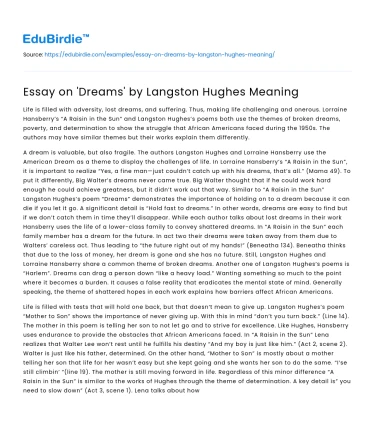Life is filled with adversity, lost dreams, and suffering. Thus, making life challenging and onerous. Lorraine Hansberry’s “A Raisin in the Sun” and Langston Hughes’s poems both use the themes of broken dreams, poverty, and determination to show the struggle that African Americans faced during the 1950s. The authors may have similar themes but their works explain them differently.
A dream is valuable, but also fragile. The authors Langston Hughes and Lorraine Hansberry use the American Dream as a theme to display the challenges of life. In Lorraine Hansberry’s “A Raisin in the Sun”, it is important to realize “Yes, a fine man—just couldn’t catch up with his dreams, that’s all.” (Mama 49). To put it differently, Big Walter’s dreams never came true. Big Walter thought that if he could work hard enough he could achieve greatness, but it didn’t work out that way. Similar to “A Raisin in the Sun” Langston Hughes’s poem “Dreams” demonstrates the importance of holding on to a dream because it can die if you let it go. A significant detail is “Hold fast to dreams.” In other words, dreams are easy to find but if we don’t catch them in time they’ll disappear. While each author talks about lost dreams in their work Hansberry uses the life of a lower-class family to convey shattered dreams. In “A Raisin in the Sun” each family member has a dream for the future. In act two their dreams were taken away from them due to Walters’ careless act. Thus leading to “the future right out of my hands!” (Beneatha 134). Beneatha thinks that due to the loss of money, her dream is gone and she has no future. Still, Langston Hughes and Lorraine Hansberry share a common theme of broken dreams. Another one of Langston Hughes’s poems is “Harlem”. Dreams can drag a person down “like a heavy load.” Wanting something so much to the point where it becomes a burden. It causes a false reality that eradicates the mental state of mind. Generally speaking, the theme of shattered hopes in each work explains how barriers affect African Americans.
Life is filled with tests that will hold one back, but that doesn’t mean to give up. Langston Hughes’s poem “Mother to Son” shows the importance of never giving up. With this in mind “don’t you turn back.” (Line 14). The mother in this poem is telling her son to not let go and to strive for excellence. Like Hughes, Hansberry uses endurance to provide the obstacles that African Americans faced. In “A Raisin in the Sun” Lena realizes that Walter Lee won’t rest until he fulfills his destiny “And my boy is just like him.” (Act 2, scene 2). Walter is just like his father, determined. On the other hand, “Mother to Son” is mostly about a mother telling her son that life for her wasn’t easy but she kept going and she wants her son to do the same. “I’se still climbin’ “(line 19). The mother is still moving forward in life. Regardless of this minor difference “A Raisin in the Sun” is similar to the works of Hughes through the theme of determination. A key detail is” you need to slow down” (Act 3, scene 1). Lena talks about how she used to be tenacious as a young girl. That sadly changed when she lost all hope in this scene. Therefore, Hansberry and Hughes’s work both have a similar theme of perseverance.
Langston Hughes and Lorraine Hansberry both use the theme of poverty to indicate that it was difficult for African Americans to obtain a better life. In Harlem a poem written by Hughes states “Because we’re colored” (line 15). During the early 1900s, many African Americans were poor because they were either unemployed or their job didn’t pay very much. Also when payday came taxes would increase. Thus making them even more financially unstable. Corresponding to the poem “Harlem” in the play “A Raisin in the Sun” it is clear that the Younger family is not economically wealthy “Travis is asleep on the make-down bed at the center” (Narrator 27). The Younger family is in a dreadful state and because of this Travis, the youngest member of the family has to sleep in the living room. Of course, both authors illustrate the theme of indigence, but Hughes’s work isn’t just focused on one family but different people. In “Brass Spittoons” a man has to clean hotel spittoons to provide for his family “Buy shoes for the baby” He works during the weekdays cleaning and only gets paid very little and then uses what he has to buy his baby shoes. Nonetheless, “A Raisin in the Sun” has a connection to the works of Hughes. A point often overlooked is “Well, I ain’t got no fifty cents this morning,” Ruth told Travis that she didn’t have fifty cents because that’s all they have. In brief, African Americans during the 1900s suffered from poverty.
The many works of Langston Hughes are similar to the play “A Raisin in the Sun”. Even though they are slightly different they still share the same themes of determination, poverty, and the loss of the American dream. Illustrating how money and social status can affect the way people see their future. Showing the life of African Americans during the early 1900s.






 Stuck on your essay?
Stuck on your essay?

